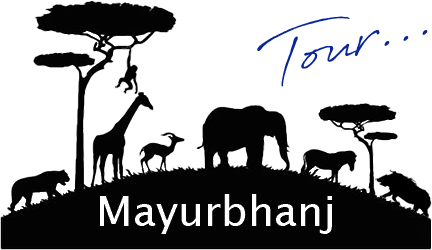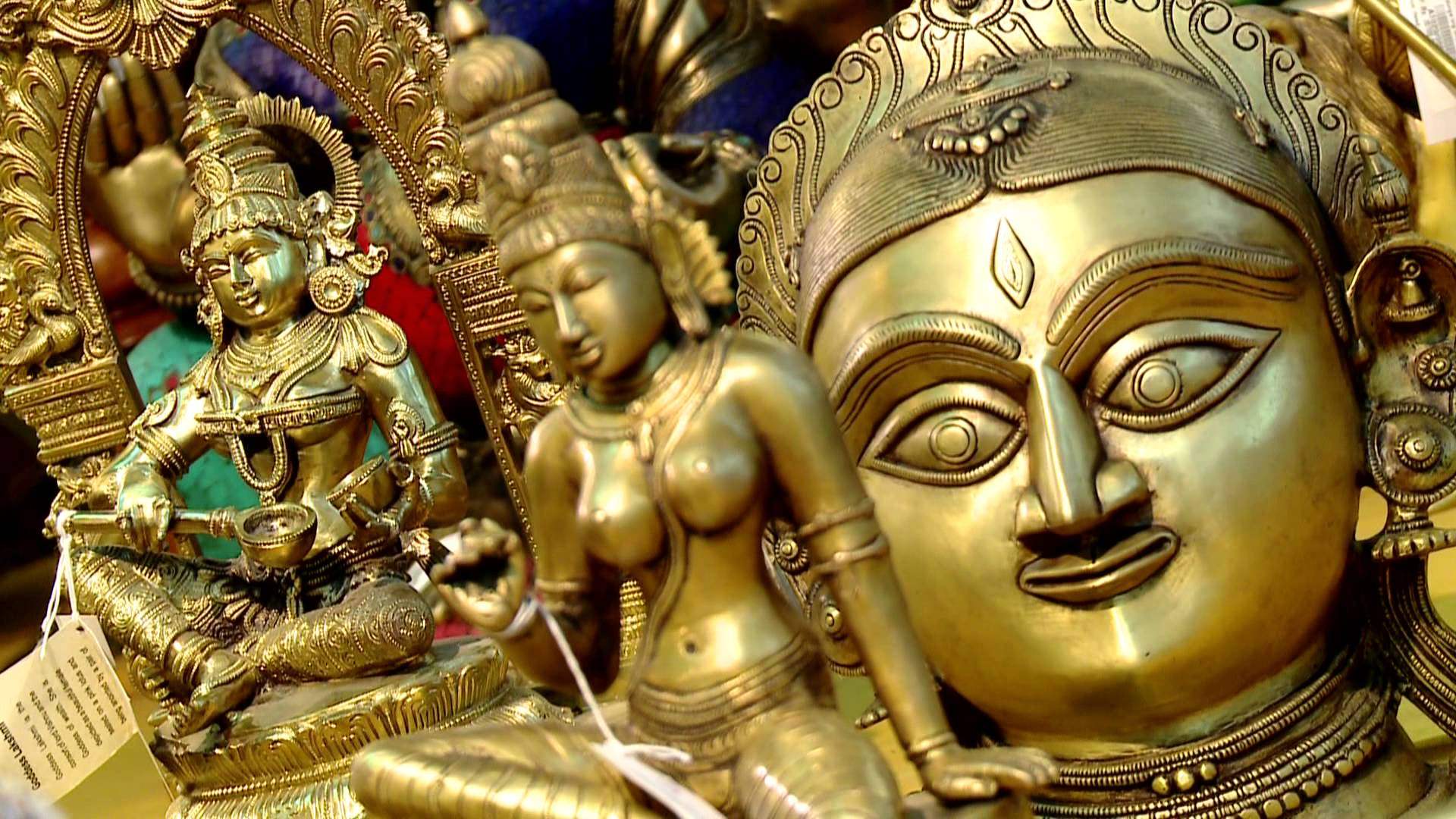Introduction
Though not native to Mayurbhanj, Dhokra craft has become integral part of this culture now. Go to any mela or just roam around on the streets of Baripada, you will often see road side dwellers and shops waiting for customers and enthusiasts with their beautiful metal sculptures. These beautiful looking sculptures are often in the shape of animals, decors, household items or more commonly known god and goddesses.
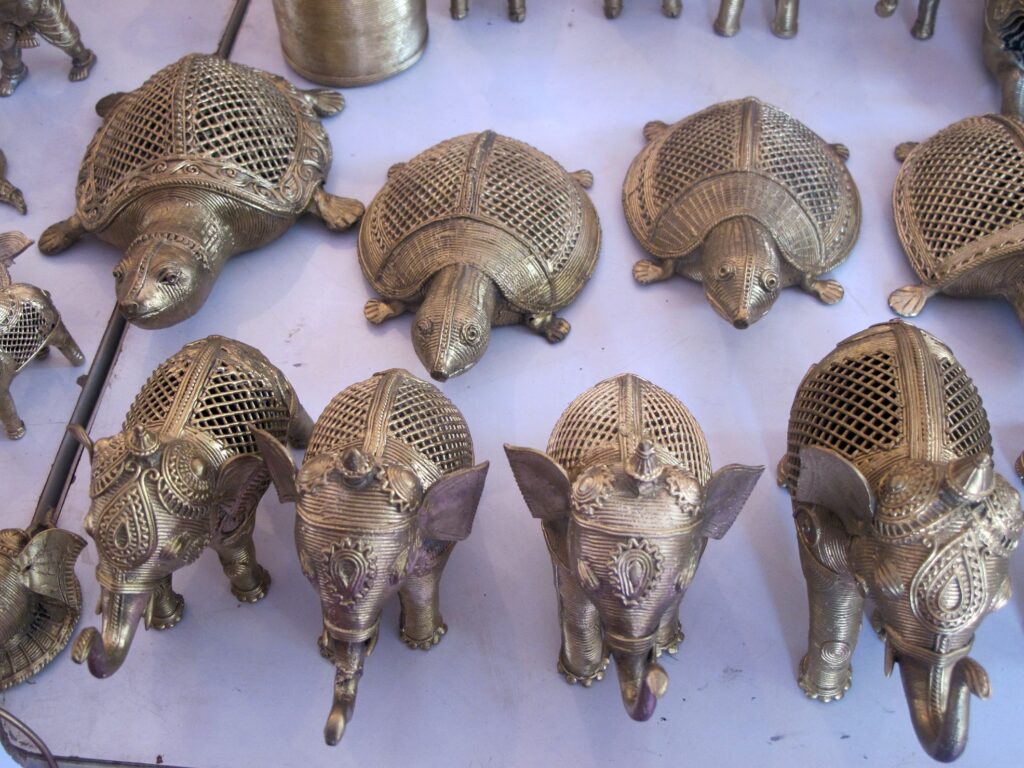
History
Lost wax process was practiced in India since the Bronze Age (3000-1800BC). The beautiful dancing girl found in Mahenjodaro is evidence of that metal craft is an integral part of Indian culture.
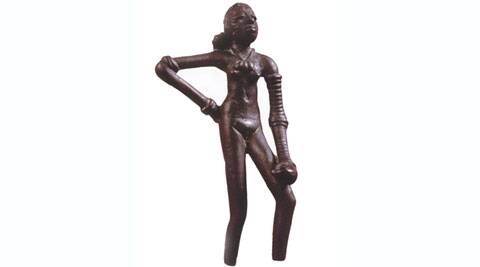
However as per recorded history of Mayurbhanj, during the time of feudal state, impressed with the crafting skills, the king Purna Chandra Bhanja Deo had invited the Thatari,who were known for their skills of Dhokra. The family moved to the village Kuruma near Karanjia subdivision of Mayurbhanj district which is 120 km away from their village (Fig. 1).
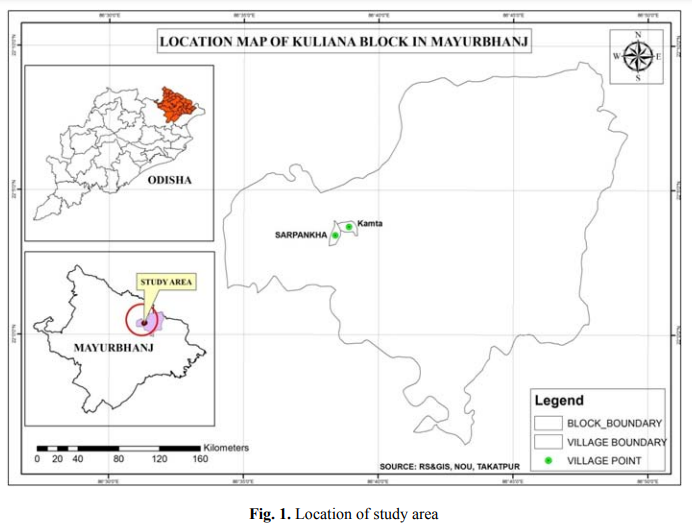
Those days this family used to build utensils for the royal family. According to the district gazette “thatari caste are a class of brazier and brass workers. Their number is rather few in the district.”- (N. Senapati 1967: 115).
Mayurbhanj was also home to several cultural rich communities as well. Among those Rana (the bania) family were in close association with these metal craftsman families to manufacture attractive range of decorative objects using a variety of metal like kanga (brass), Pittal, aluminum etc which they (Rana) used to sell in different parts of country and abroad.
Earlier these families also used to prepare “eight metal amalgam” famously known as astadhatu deities and jewelry for the king. The astadhatu (Eight Metal) consisted of Gold (suna),Silver (rupa), Copper (tomba), Iron (luha), Zinc (dosta), Tin (tino), Lead (sisa) and Mercury (paroda).
Tools & Procedure
This article is written on a research paper which focuses on anthropological study of traditional knowledge on metal craft Artisan of Sarpankha, village of Mayurbhanj district Odisha.
Here I tried to describe the process of manufacturing and technique related to it. Currently in Mayurbhanj the dhokra craftsman are living in the villages like Kuliana, Kamta, Sarpenkha, Paniakuili, Pachesahi, Kuliakhunta, Chitrada, Lehakemi etc.
Materials needed
Dhokra casting artisans use various equipment that can be found easily in nature. Tools are often self made and doesn’t need heavy machines. Few items are often purchased from local market.
The basic materials like Resin, salt, clay, sand, paddy chaff and wood can all be found in the village easily.
Other materials required for the preparation of the dhokra crafts are:
Working board-maham pidha (working wood board),
Modeling stick (kelub kathi),
Beeswax-(Maham) is purchased from the village, where it was collected by the tribal people.
Resin (jhuna),
Grinding slab (the clay paste is groung with this stone) and hand stone (silo putta) iron blade, (Arisi patia) the wax press (Janta),
clay (mati),
lado ( fired clay) the fired shards of the clay forms are finely ground and mixed with the fresh clay to make it stronger against high temperature.
cow dung (gobor),
sickle (daa),
hammer (Hatudi),
Chisel (Chhini),
weight machine (dandi),
brass (pittal) when the brass objects like bowls, water vessels, measuring bowls worn out such items are sold to scrap metal dealer at half rate.
Salt(luno),
long picher (Bada Sanduasi),
hand blower earlier the villager were using goat skin as a blower, (funka), fire pit cover with broken earthen pot,(kalasi vanga).
Mold preparation
The dhokra technique started with the preparation of mould (chhancha) of different
vessel animal, household object, and figures, all prepared with clay. The clay core defines the hollow space of the brass object. It shows the desired objects in a smaller and simplifier forms. There are two types of core used by the caster, the opened core and the closeded core. In open core casting there is one or more opening forms used to scrape out the clay core after firing the core paste. Gobar mati (cow dung mixed with soil) is used. The soil from the paddy farm which contains isless is collected after the harvesting of crops. Initially the artisans pounder the soil, sieved and soaked in water and mixed with cow dung. They use 3:2 soil and cow dung as per the necessity of proportion. The soil is kneaded untill it reaches the leather hand condition and is then ready for mould building. After the preparation of the mould as per their own requirement, the clay core is dried under the sun. When the clay core is dry the surface is smoothed out with the thumb and rubbed with the green leaves. The leaves juice helps to create a better adhesion of the wax. For the closed core paste (Chitamati) sticky clay with sand is used for preparation. 6:4:1 (Clay:Sand:Jute). These potato jute bags are used as jute after cut in the small pieces. Clay doesn’t need to be removed after casting. When left in the hollow from a solid casting can be feigned and thereby and higher price claimed for the greater weight.
Wax preparation
The wax is purchase from the market at the rate of 300/ kg. The wax from wild bees is
rarely available. To make it more pliable resin (Jhuna) is mixed with wax 1:10 proportion (resin:wax). A clay pot is set on fire. Resin is melted on that clay pot then the wax is added. The mixture is brought to a boil for ten minutes while being constantly stirred with a bamboo stick. Then the wax is filtered through a cloth. The boiled waxes are filtered over a vessel filled with water. The liquid wax which is lighter then water congeals on the surface of the water.
Production of wires
Two wooden press stick (Jhanta badi) of one meter long are needed for the production of wires. One is the (Andiapata) male plank another is female plank (Maipata). The (Janta phungi) socket consists of a self cast brass or an aluminum cylinder which has heirloom with symbols engraved around the rim. Various round sieves are prepared with Indian aluminum. Coins (Chaki) can be inserted into the cylinders bases with holes using various sizes nails. The wax is needed and pressed until it reaches the desire ductility. The wooden plunger (Sulat) is fitted with the brass or aluminum cylinder (phungi). The brass or aluminum cylinder (phungi) with wooden plunger is kept on female plank (Maipata). The wooden plunger is pressed with male plank (Andia pata) on to the wax. Pressure occurs through the use of the whole body with the abdomen pushing to male plank towards. The things in this manner wax threads formed through the sieve coin.
Coiling of wax thread
The craft man covers the surface of the mould with wax thread with a diameter of 0.5 to 1.5mm coil. The thread is laid tightly without flattening it. Different portion of the model like head, arm, leg, neck are separately decorated by wax. If the spiral coils do not join up, then the modeling stick (kalup kolhi) is used. A saddle (Pidha) of 42 X 17 X 8 serves as marking block for handing wax. The semi-rounded hand block (situni) is used for rolling wax into thread or pounding it into sheets on the working block. The spur is either pressed or welded on to the area where it optimally benefits (Fig. 2).
The first clay coat
After the completion of covering the wax threads, a clay coat mixed with cow dung
(palkhania gabarmati) is applied. The clay coat consists of the same materials as for the core paste in the open-core technique, with the mention that the water quantity is higher in this case. The first clay consists of 3:2 (soils: cow dung) and it’s used to produce all the details of the wax surface. The larger is applied to a thickness of 0.4 C.M. However, on the spur a coat of 0.8 C.M. is applied. No inclusions should be allowed to develop; otherwise during casting process metal could be filling it. For smaller item one channel is provided and for the big items more than one channel is provided. Then the embedded form in kept under the blazing sun to dry.
Fixing the closed core
The tin triangles are prepared in a zigzag manner with a hammer and chisel, a piece of iron is place on bottom to chop in properly. These tin triangles are gently trapped all around through the clay and waxes. The core needs to be fixing, otherwise it would move freely in the hollow space created when the wax has melted away. The triangles fly in all direction at intervals of about 4 cm.

The second clay coat
The soil clay is mixed with sand. Initially soil is pounded, sieved and soaked in water.
The soil, sand and jute (proportion is 6:4:1), then the jute is mixed and needed in to a lump of clay with water. The coat is applied about 0.8cm thickness. When working with the clay a bowl of water is always kept nearby because sometimes the first clay coat needs to be moistened with water so that the binds batter with the second one. The lumps of clay are completely covered. According to the caster family the size of the wax model is permits, up to four of them can be combined into casting form. The clay is then laid out to dry overnight.
The form receivers a funnel
The Chunga or channel is developed from a lump of clay (balimati). It is a fix path way
for transformation of molten brass from the funnel like container of molten brass to the wax. The channel is placed over the wax plug in such a manner that the plug remains visible below. The joint reins forced on the outside with a thick layer of clay and make it dry under sun.
The metal and its cover
Brass metals (dhatu) are purchased from the market. Warn out brass objects like bowl, bells, measure pot, are obtained from the market at half rate of the new one RS- 500/- all are broken up in to scrap and prepare for the casting feed. The clay form channel is overfilled according to the size of the wax items. A large pinch of salt is added to the metal for flux. The cap is laid over the metal and the cap and channel are joined by using clay mixture. The clay mixture paste prepare with clay, sand and jute in 2:2:1 proportions. A thick roll of clay spread to the middle of the channel and make it dry.
Melting the metal by firing
The wood is purchased and placed on fire pit (salo – Fig. 3). Two larger or three smaller
forms are placed carefully the metal facing down, when the fire is kindled. The wood pieces catch fire. The flames turn yellow when the wax melts and burn away. The lost wax these leaves a hallow form behind into which the metal can later flow. The hard blower machine is used for increasing heat. Upper portion of clay shared placed on the top of the over to prevent the heat from escaping too quickly. It takes over to one and half hour to complete the burning when a light smoke rises and the flames turns green. It is ready to be cast using long pincher the glowing form is clasped at its upper and pulled from the fire pit and laid down on to the clay ground. Then the crucible end with the pitcher lilted up for the casting. The glowing form is cautiously and calmly laid down on to the clay ground. It is astonishing how the melting metal easily flows through quite a number of corners through the pressure of the casting head. The forms are placed upside down against a wall. After cool down b the casting coat is carefully broken and some extra rough bits retained during casting. It is bough carefully and rubberier with sand to get smooth glace.

Conclusion
During federal state the Dhokra objects were prepared for local folks, selling in local
market. It has some religions importance in this area so they prepare, Laxmi, Ganesh, Elephant, Laxminarayan which are honored and worship in Odisha in the month of margashira (mid NOV to mid DECEMBER) and purchased by the local people. Caster faces nearly 15 to 20% damage during casting. The dhokra art is a time consuming and linked with weather condition. During bad weather casting cannot be done. Price changes in the dhokra material because of the increasing rate of the materials and available of traditional market. Hard labor with group work and less financial gain make the Craftsmen to seek new job or force them to do other jobs. The dhokra casting is an indigenous craft facing many problems then also producing their craft material for the survival of their traditional act. In spite of institutional intervention; artisan continues to operate with traditional technology, tools, designs and informal training. Wages do not match favorable with the skill and experience of the artisans.
This study was first published in ICJ in 2015 originally written and compiled by Champak Kumar Sahu – Dept of Anthropology and Tribal studies.North Orissa University, Sriramchandra vihar, Baripada, India
